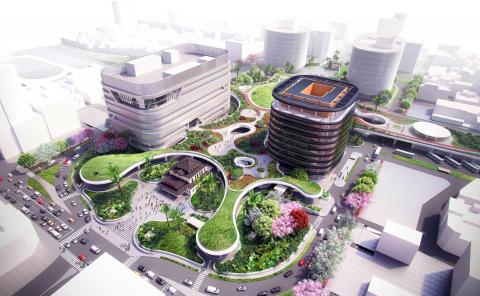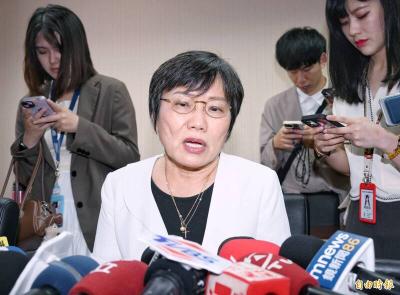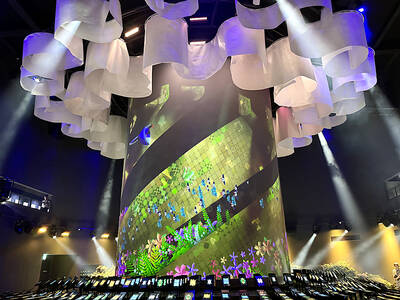Design plans for a remodeling of the historic Kaohsiung Railway Station submitted by the Dutch design studio Mecanoo have been approved by the Kaohsiung Urban Development Bureau, the bureau announced on Thursday.
The Ministry of Transportation and Communications’ plans for renovating Kaohsiung Railway Station began in 2000, but locals criticized initial plans, saying they lacked functionality, both from business and transportation points of view, and did not fit into the surroundings.
In response, the city held a series of meetings on the issues and established a communication platform to exchange ideas. The ministry then entrusted the station’s design to Mecanoo, which created a “stunning” design that both the local and central governments were pleased with, city officials said.

Photo: courtesy of Mecanoo
“The station design provides a large outdoor activity area for local residents and, taking into account the stifling heat of the south, provides lots of greenery for shade, emulating the experience of being in a traditional Taiwanese temple courtyard. The unconventional oval-shaped lights in the canopy’s ceiling create impressions of a temple lantern festival,” Kaohsiung Urban Development Bureau Director-General Lee Yi-de (李怡德) said.
Parallel walking trails and cycling paths stretch for 15km through the top of the canopy connecting the eastern and western peripheries. Climbing the station’s canopies, visitors can take in the beauty of the Shoushan (壽山) and Beidawu (北大武山) mountains in the distance.
“To create a sense of melding the old and the new, the old colonial-era Japanese station is to be moved to a spot along the central axis of the new station. The encircling of the old station by the new one will lend itself to an atmosphere of continued traditions,” Lee said.
The publishing of a simulated image of the new station a few days ago by the Architect’s Newspaper proved popular online. Netizens called the design “stunning” and asked: “Can Taipei Railway Station still be saved?”
“The station’s design escapes the old engineering thought process of prioritizing functionality and takes the liberation of space brought about by underground transportation a step further, acting as an important marker for emphasis on activity space for the public,” a bureau statement said.
After deliberating on the new plans, the ministry would be urged to begin work on the project as soon as possible, with the aim of completing the station by 2023, bureau officials said.

Chinese Nationalist Party (KMT) Chairman Eric Chu (朱立倫), spokeswoman Yang Chih-yu (楊智伃) and Legislator Hsieh Lung-chieh (謝龍介) would be summoned by police for questioning for leading an illegal assembly on Thursday evening last week, Minister of the Interior Liu Shyh-fang (劉世芳) said today. The three KMT officials led an assembly outside the Taipei City Prosecutors’ Office, a restricted area where public assembly is not allowed, protesting the questioning of several KMT staff and searches of KMT headquarters and offices in a recall petition forgery case. Chu, Yang and Hsieh are all suspected of contravening the Assembly and Parade Act (集會遊行法) by holding

PRAISE: Japanese visitor Takashi Kubota said the Taiwanese temple architecture images showcased in the AI Art Gallery were the most impressive displays he saw Taiwan does not have an official pavilion at the World Expo in Osaka, Japan, because of its diplomatic predicament, but the government-backed Tech World pavilion is drawing interest with its unique recreations of works by Taiwanese artists. The pavilion features an artificial intelligence (AI)-based art gallery showcasing works of famous Taiwanese artists from the Japanese colonial period using innovative technologies. Among its main simulated displays are Eastern gouache paintings by Chen Chin (陳進), Lin Yu-shan (林玉山) and Kuo Hsueh-hu (郭雪湖), who were the three young Taiwanese painters selected for the East Asian Painting exhibition in 1927. Gouache is a water-based

Taiwan would welcome the return of Honduras as a diplomatic ally if its next president decides to make such a move, Minister of Foreign Affairs Lin Chia-lung (林佳龍) said yesterday. “Of course, we would welcome Honduras if they want to restore diplomatic ties with Taiwan after their elections,” Lin said at a meeting of the legislature’s Foreign Affairs and National Defense Committee, when asked to comment on statements made by two of the three Honduran presidential candidates during the presidential campaign in the Central American country. Taiwan is paying close attention to the region as a whole in the wake of a

OFF-TARGET: More than 30,000 participants were expected to take part in the Games next month, but only 6,550 foreign and 19,400 Taiwanese athletes have registered Taipei city councilors yesterday blasted the organizers of next month’s World Masters Games over sudden timetable and venue changes, which they said have caused thousands of participants to back out of the international sporting event, among other organizational issues. They also cited visa delays and political interference by China as reasons many foreign athletes are requesting refunds for the event, to be held from May 17 to 30. Jointly organized by the Taipei and New Taipei City governments, the games have been rocked by numerous controversies since preparations began in 2020. Taipei City Councilor Lin Yen-feng (林延鳳) said yesterday that new measures by